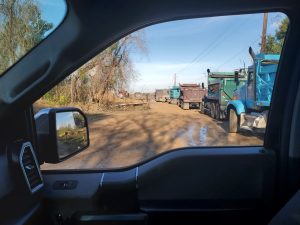Cut: Earth that is removed from an area is considered “cut” or excavated earth. Areas where the existing elevation exceeds the desired elevation.
Fill: Earth that is brought into an area is considered “fill” or embankment earth. Areas where the existing topography lies below the desired elevation line are the “fill” spaces.
2-dimensional diagrams: At their most basic, cut and fill diagrams show a location along an X-axis with a positive or negative Y-axis, quantifying the amount of cut or fill with a negative or positive number, respectively. Since land exists in three dimensions, these diagrams must be created for multiple cross-sections of the landscape at regular intervals.
3-dimensional diagrams: 3-dimensional maps are more modern solutions for cut and fill excavation projects. The terrain is first measured using accurate surveying equipment, and the data points are used to create a software-generated model of the terrain. Once the base model is complete, the planner creates a model of the desired terrain and lays it over the existing terrain model to identify the cut and fill areas in three dimensions. Software models may highlight cut vs. fill areas with different colors that vary based on value ranges.- Cross-Section Method
The cross-section method of calculation is a common method used with the 2-dimensional method of mapping. With this method, cross-sections of the existing and proposed land levels are measured at regular intervals across the site. The cut and fill area is determined for each cross-section, then adjacent cross-sections are compared and the averages of their cut and fill areas are multiplied by the distance between them. This is done for each adjacent pair of sections, then the total volumes are added together to create the complete cut and fill volumes for the project.
The cross-section method of calculation is considerably more time-consuming than automatic methods of calculating volume, and the accuracy of the method depends on the distance set between sections. Closer sections result in greater accuracy but take longer to calculate, while further sections are less accurate but take less time to calculate.
- Grid Method
The grid method of calculation involves drawing a grid onto the plan for the earthwork project. For each node of the grid, determine the existing and proposed ground level and calculate the cut or fill required. Once the cut or fill depth is calculated, multiply the value by the area of the grid cell. Do this for each square of the grid, then add the volumes together to determine the total cut and fill volumes for the project.
Like the cross-section method of calculation, the grid method takes time to implement and is significantly more time-consuming than any automatic systems. Additionally, the accuracy of the grid method depends on the size of the grid cell. Larger cells take less time to calculate but are less accurate, while smaller cells are more accurate but take more time to calculate.
- Automated Methods
If you’re using an earthwork software, you may not need to use one of the manual methods above. Instead, the software will run the calculations for you. It should be noted that these software systems are faster but not inherently more accurate — for example, some software calculations are based on high-density versions of the cross-section or grid methods. However, automated systems often use more sophisticated calculation methods, such as the triangular prism method.
Synopsis
The second season of the anime is set in the “Entertainment District” arc from the manga. The series follows the character of Tanjiro Kamado as he tries to become a demon slayer after his family was murdered and his siter turned into a demon. After an encounter with Giyū Tomioka, a demon slayer, Tanjiro is recruited by Giyū and sent to his retired master Sakonji Urokodaki for training to also become a demon slayer, beginning his quest to help his sister turn into human again and avenge the death of his family.
After two years of strenuous training, Tanjiro takes part in a formidable exam and is one of the few survivors to pass, officially making him a member of the Demon Slayer Corps. He begins his work of hunting down and slaying demons alongside Nezuko, who has been hypnotized to bring no harm to humans and who occasionally helps him in battle.
Season 2
Through the second season we follow him as he and his friends who have also survived the Demon Slayer examination are sent on a mission within the Entertainment District, which is filled with demons and where vices take priority over anything else. They journey together alongside Sound Hashira and Tengen Uzui in search of a monstrous foe that had been terrorizing the town.
Streaming & Online Watching

You can watch the series on either Crunchyroll or Funimation as the series has been licensed by Aniplex of America to be streamed anywhere outside of Asia. To those who live in Asia, the second season can be streamed using
- Viu
- Netflix
- WeTv
- Bilibili
- and even iQIYI.
The Legacy

As of February 2021, the manga had sold over 150 billion copies worldwide making it the eighth best selling series of all time.
Recommendations
If you’re new to the series and are not sure if this is up your alley, Kimetsu no Yaiba is a shounen manga and anime. Characterized by high action and humorous subplots. But as far as genres go, it has the tags dark fantasy, martial arts, and adventure as its main subpoints. If any of these things strike your fancy, try looking into the first season of the anime before embarking on the second season and don’t forget to also watch the movie before getting to this one.


